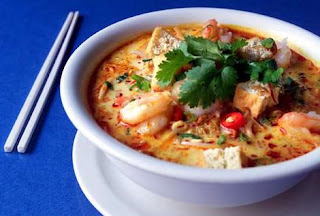Sweet and sour fish

Ingredients * 1 large fish such as lapu-lapu or tilapia * 1 large onion, sliced * 1 each of red and green bell pepper, julienned * 4 cloves garlic, crushed 2 tablespoons ginger, julienned 1 cup vinegar 1 tablespoon salt 3 tablespoon sugar 1 tablespoon cornstarch, dissolved in 1/2 cup water 1/2 teaspoon MSG or vetsin 1 cup cooking oil * 1 carrot, sliced (optional only) Instructions 1. Clean the fish and rub with salt and vetsin. 2. In a frying pan, heat the oil and fry the fish until golden brown. 3. Place the fish in a serving dish and set aside. 4. Remove the used oil from the pan and put in about 1 tablespoon of fresh oil. 5. Saute the garlic, ginger, and onion. 6. Add the bell peppers and saute until half-cooked. 7. Put this mixture on top of the fish in the serving dish. 8. Return the pan to the heat and put the vinegar, salt and sugar. 9. Bring to a boil a








